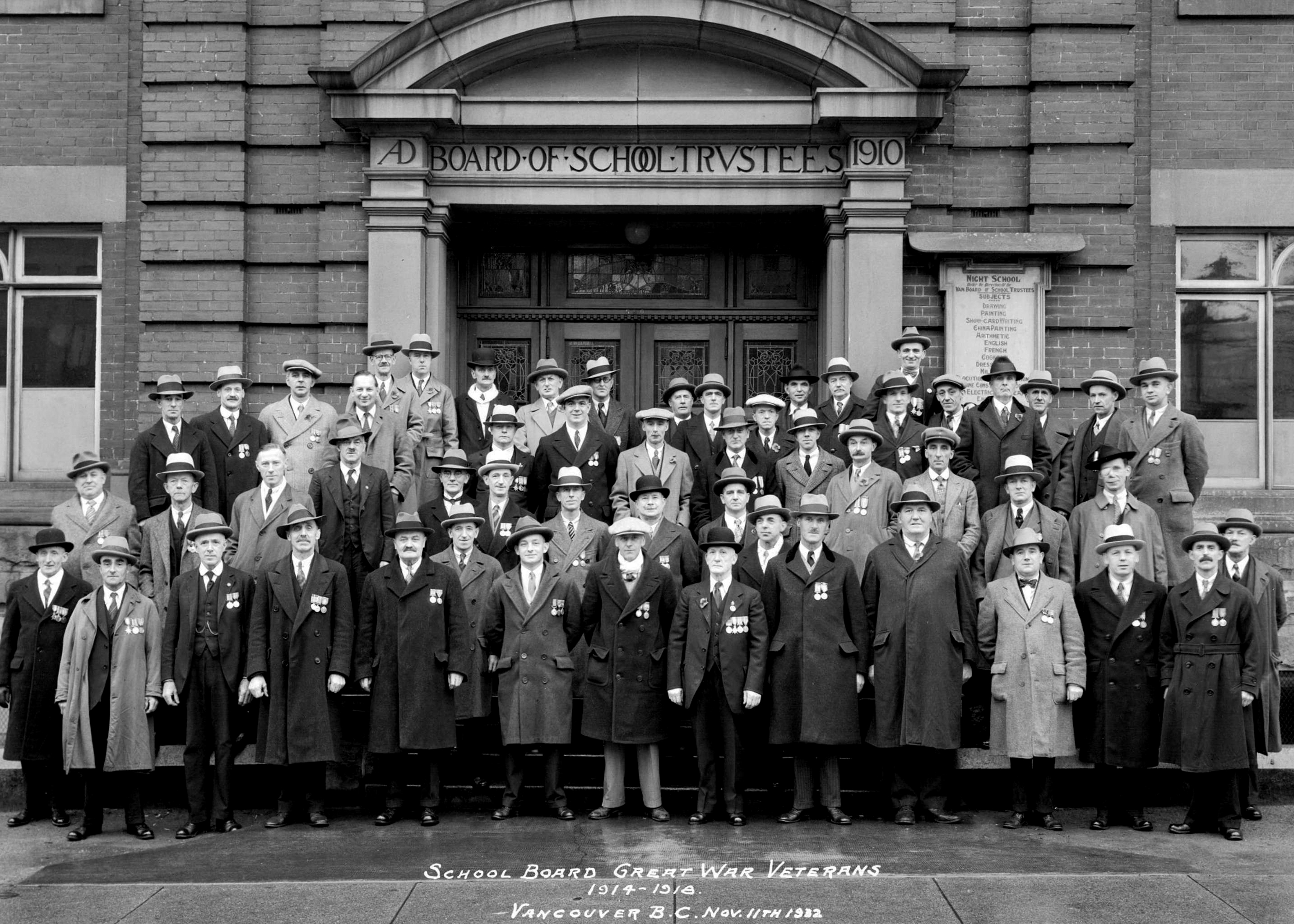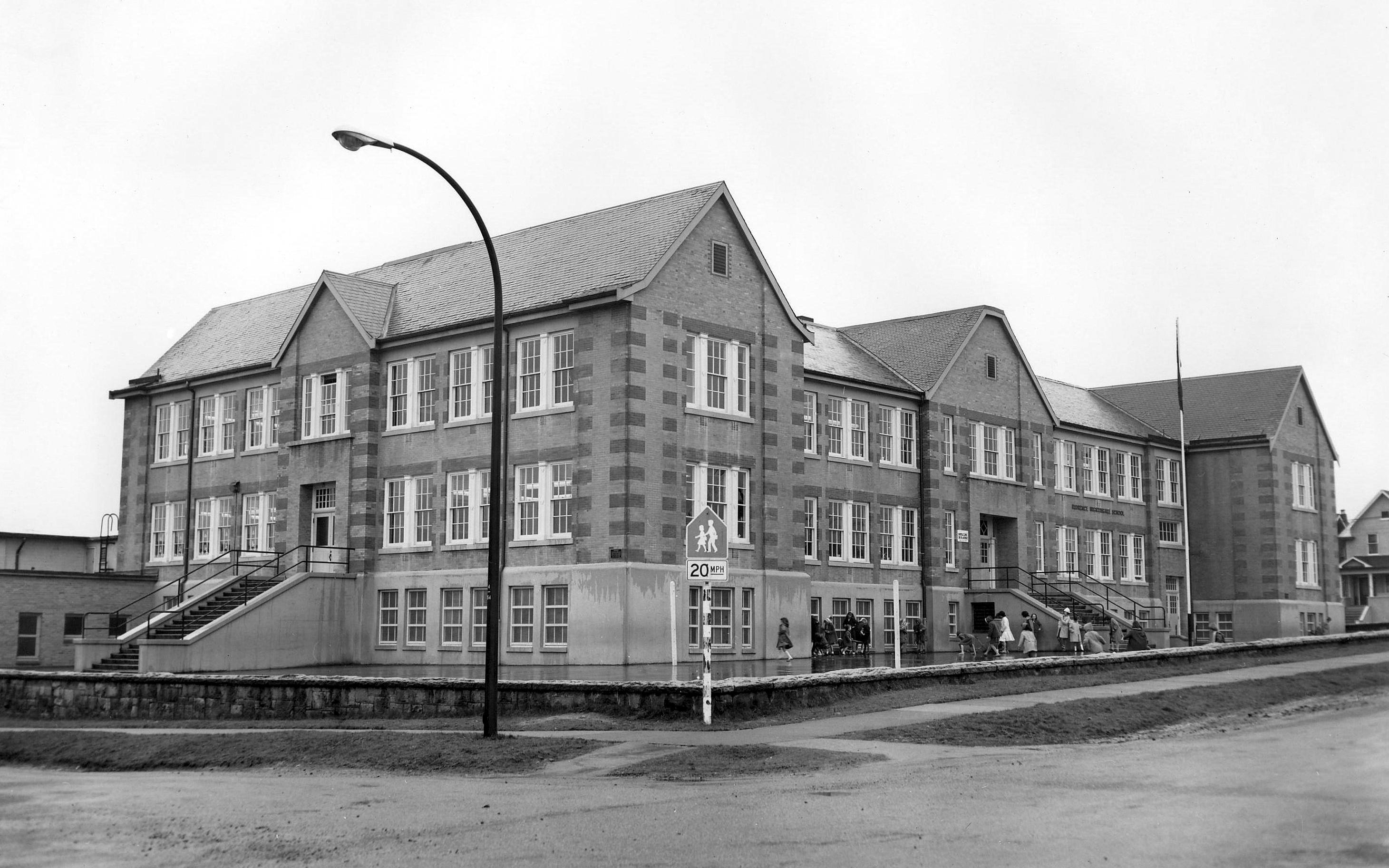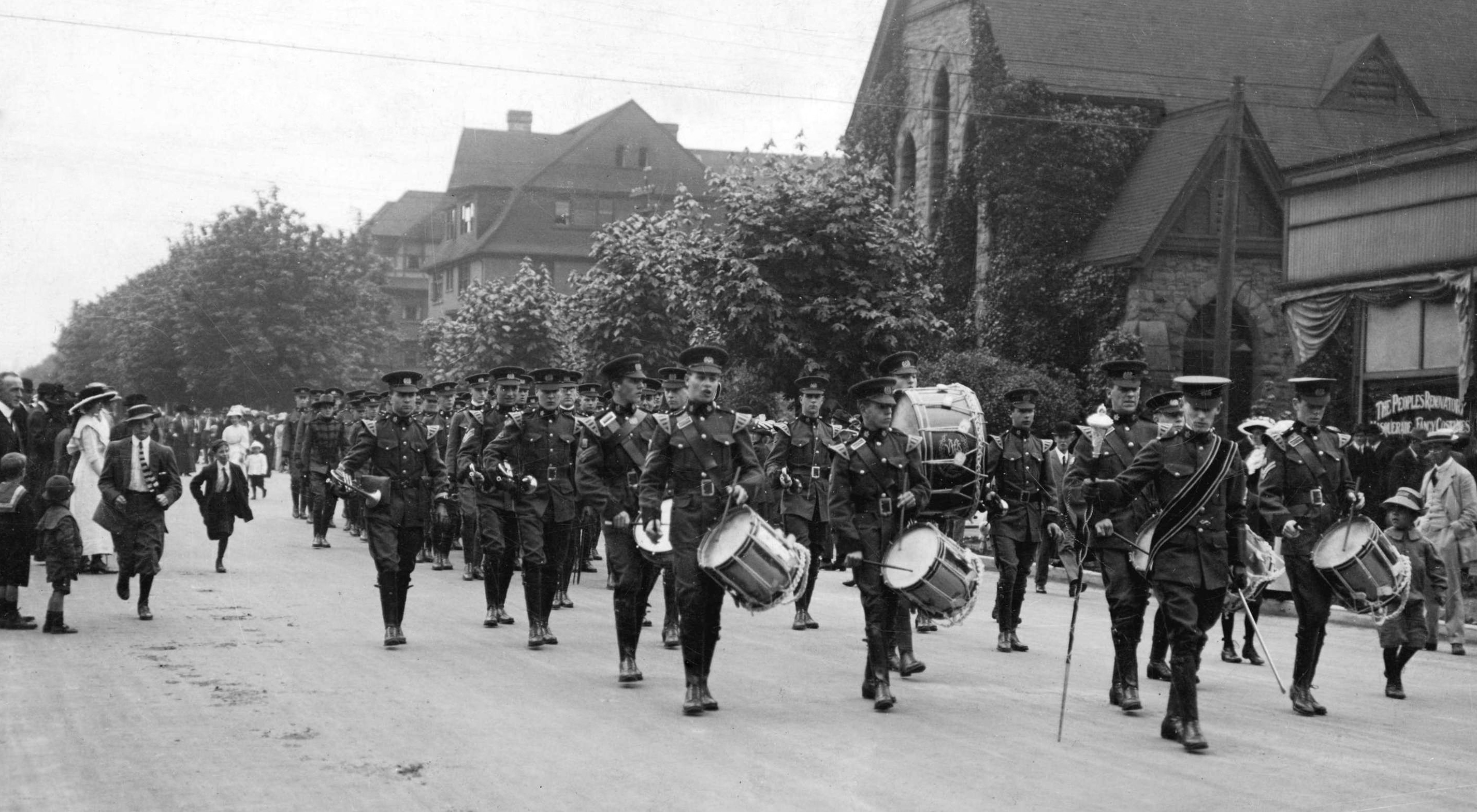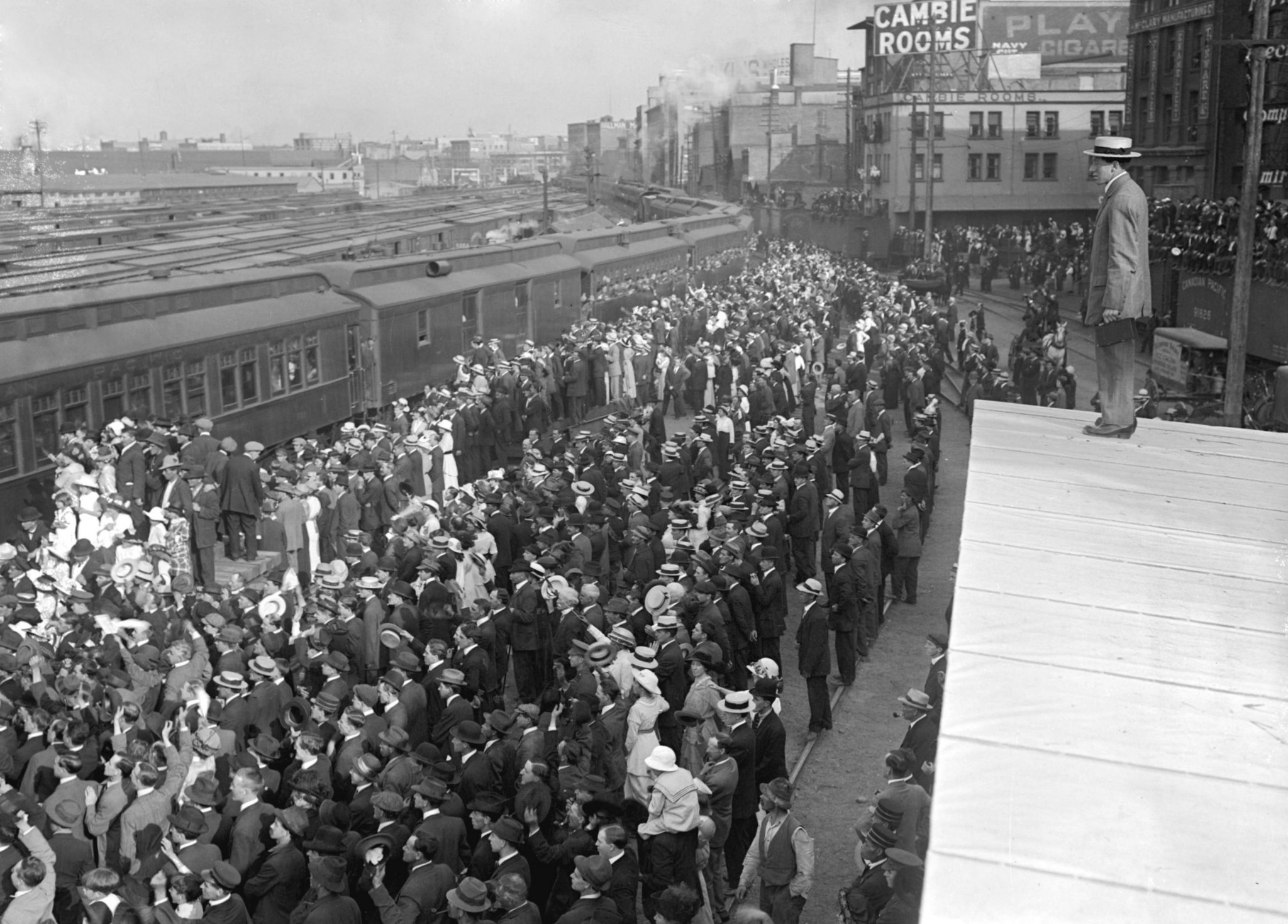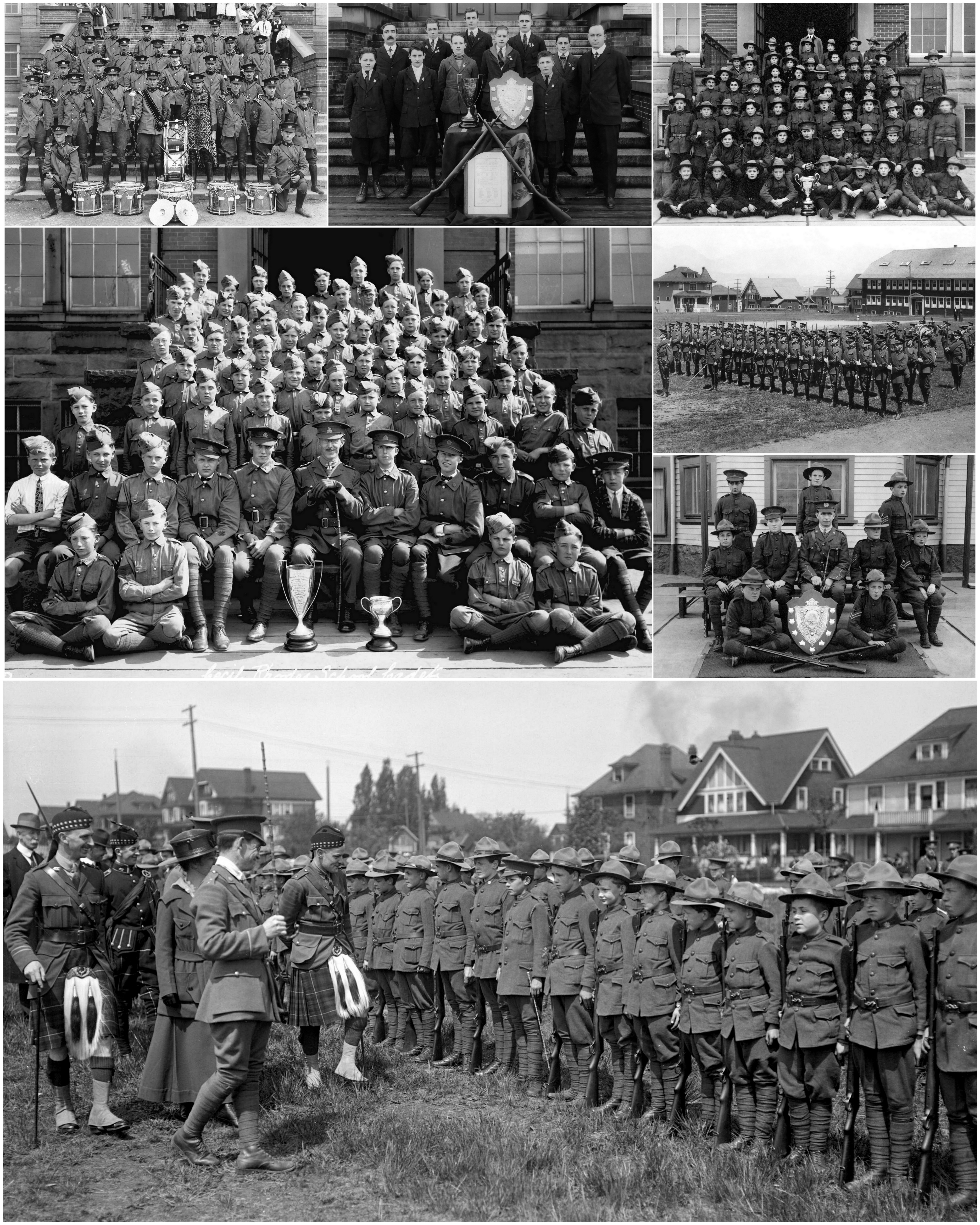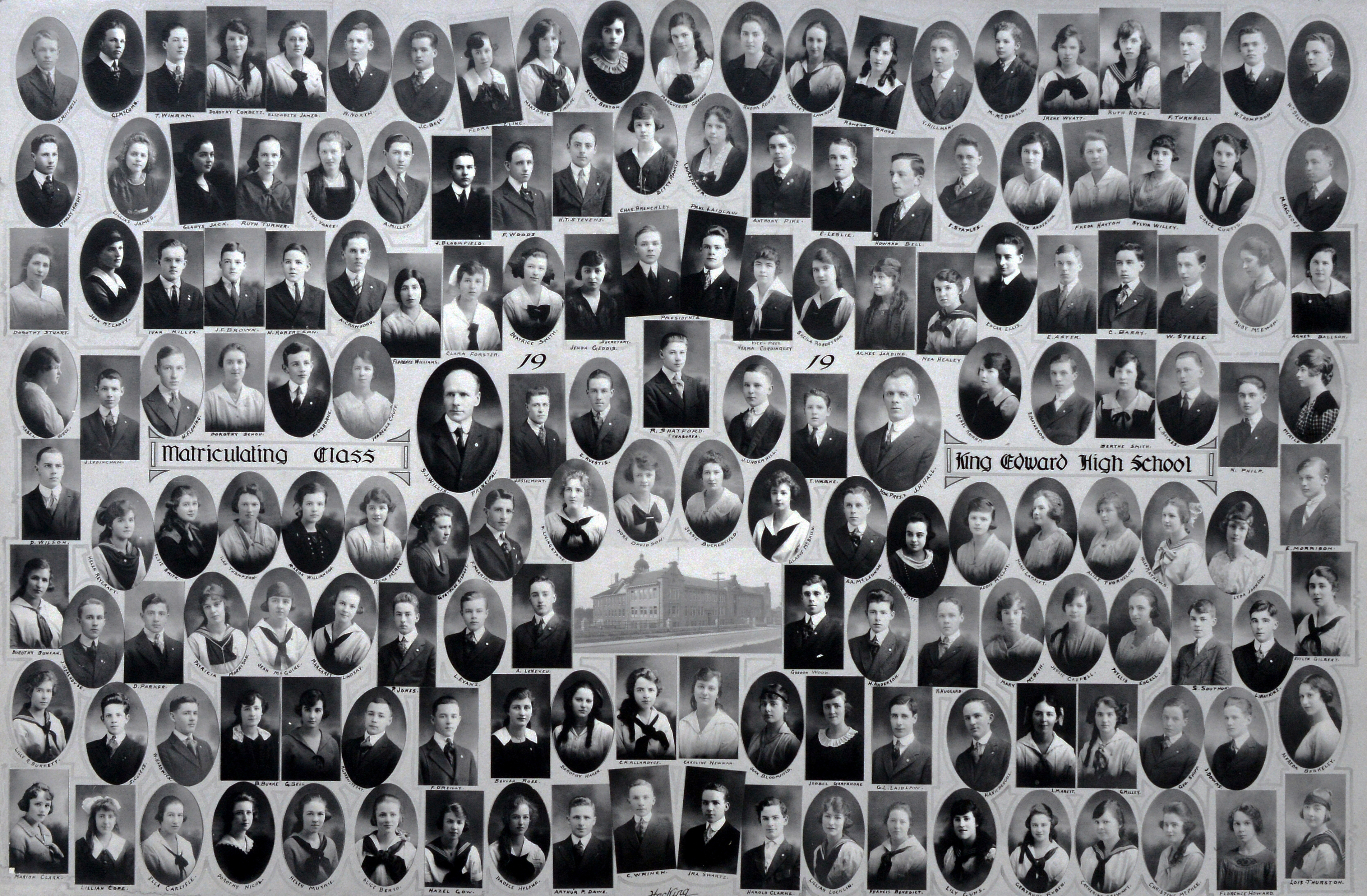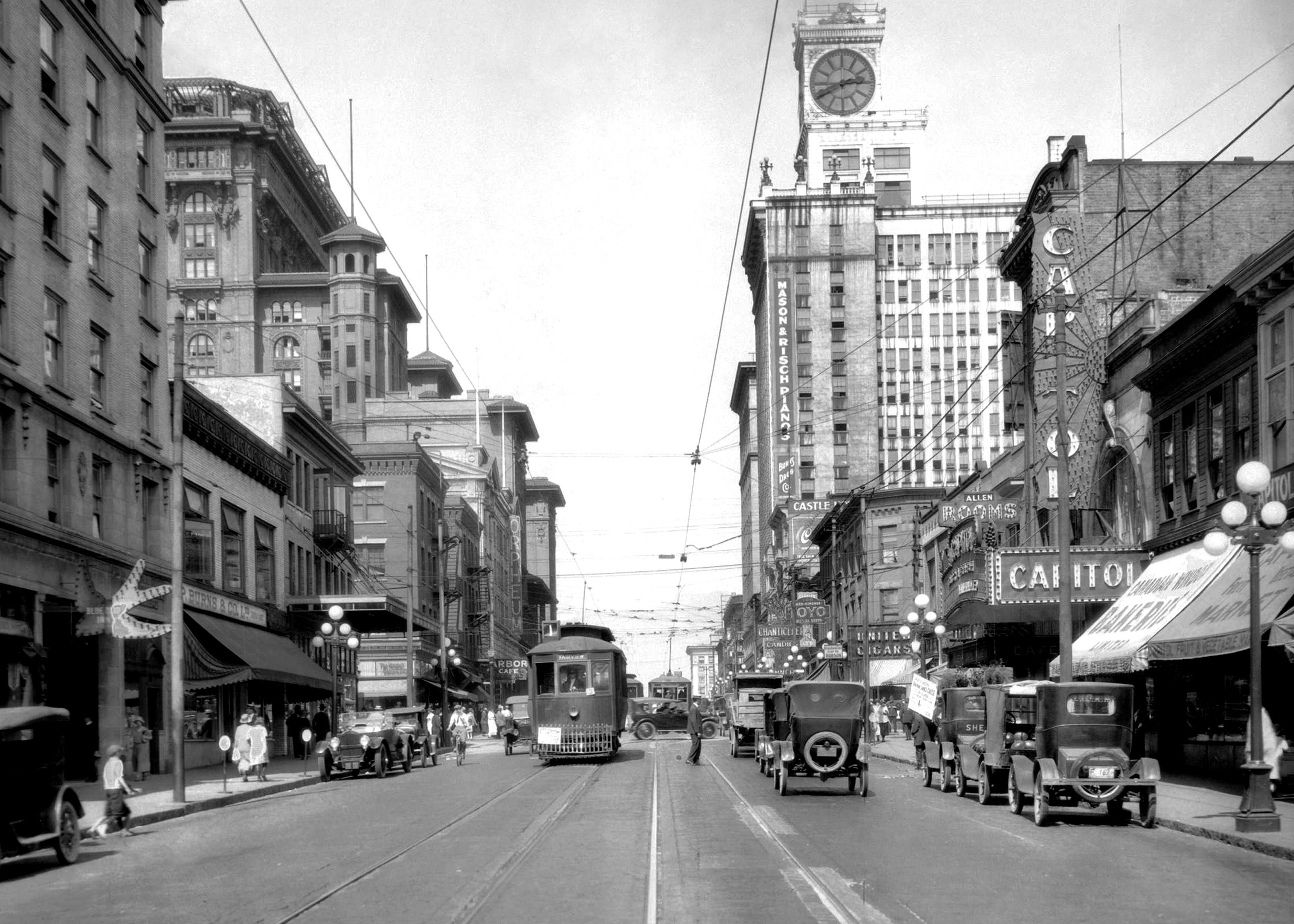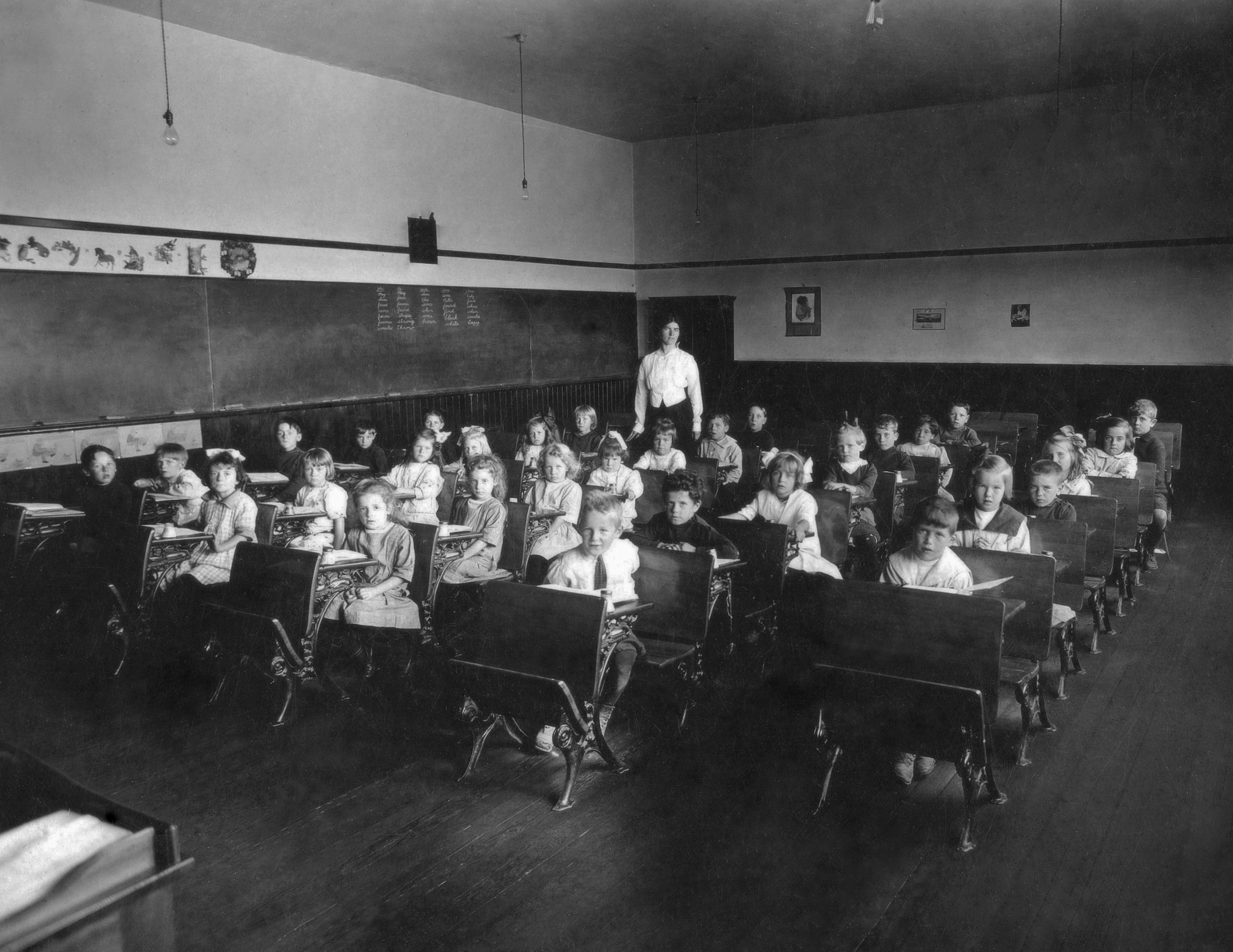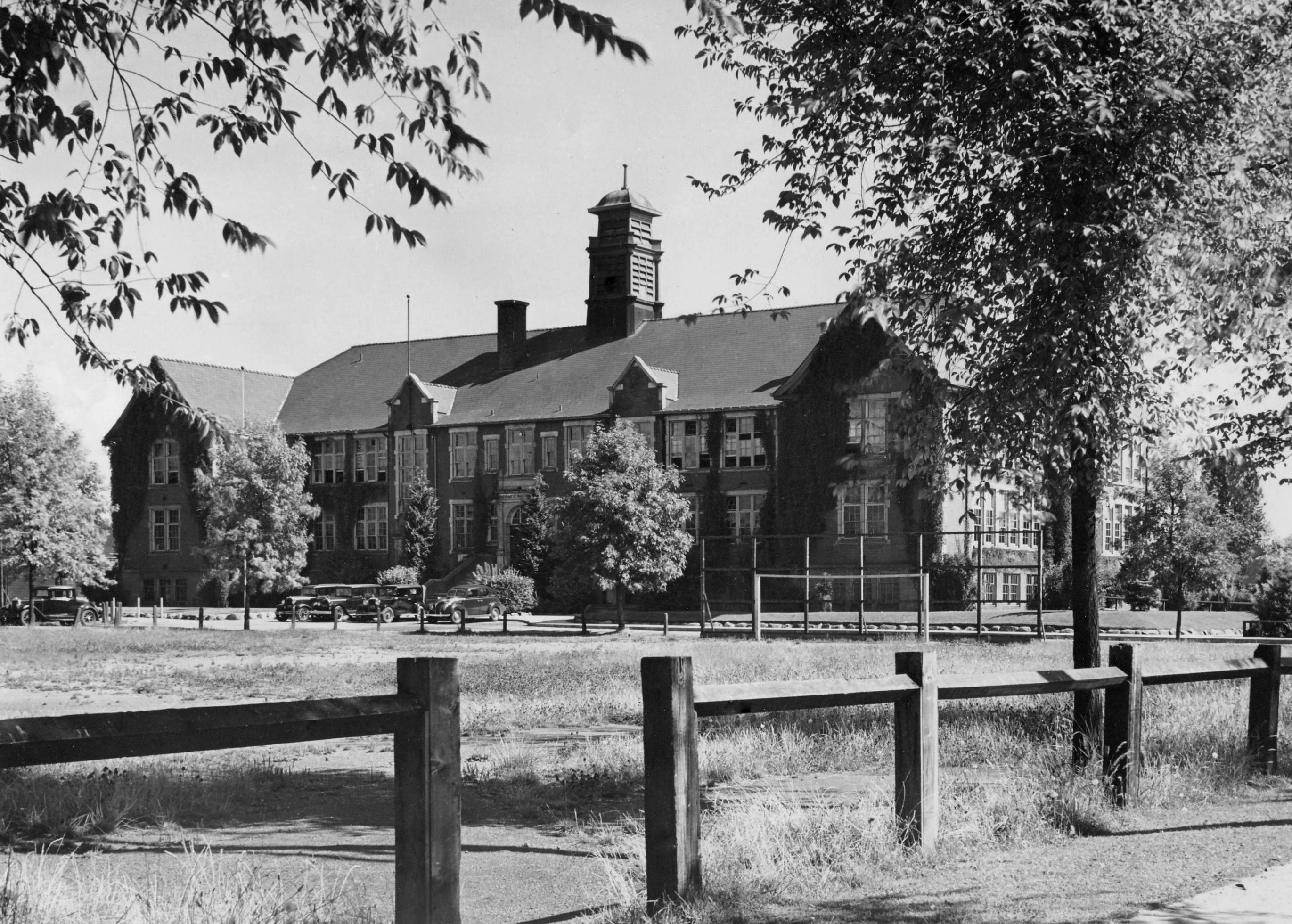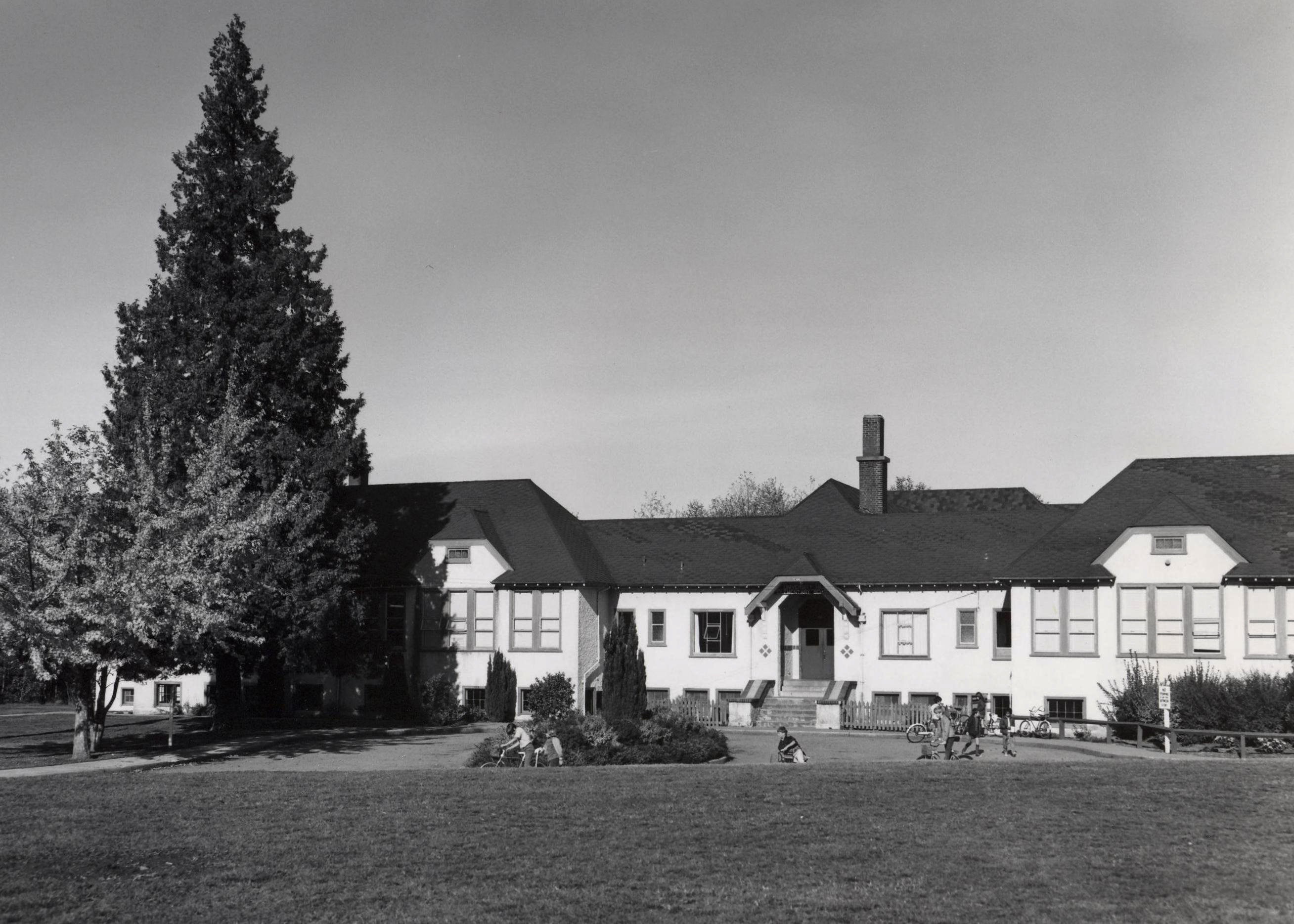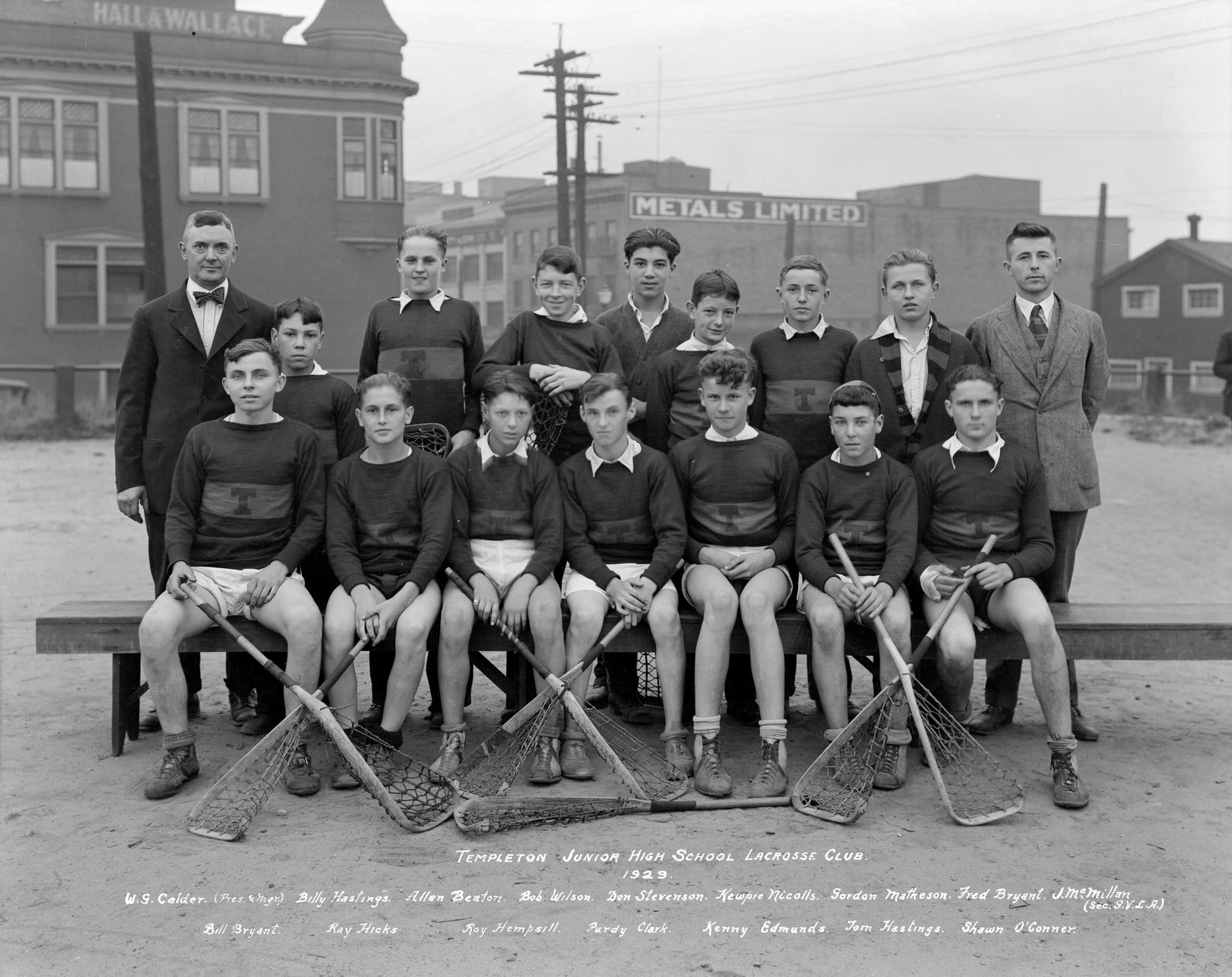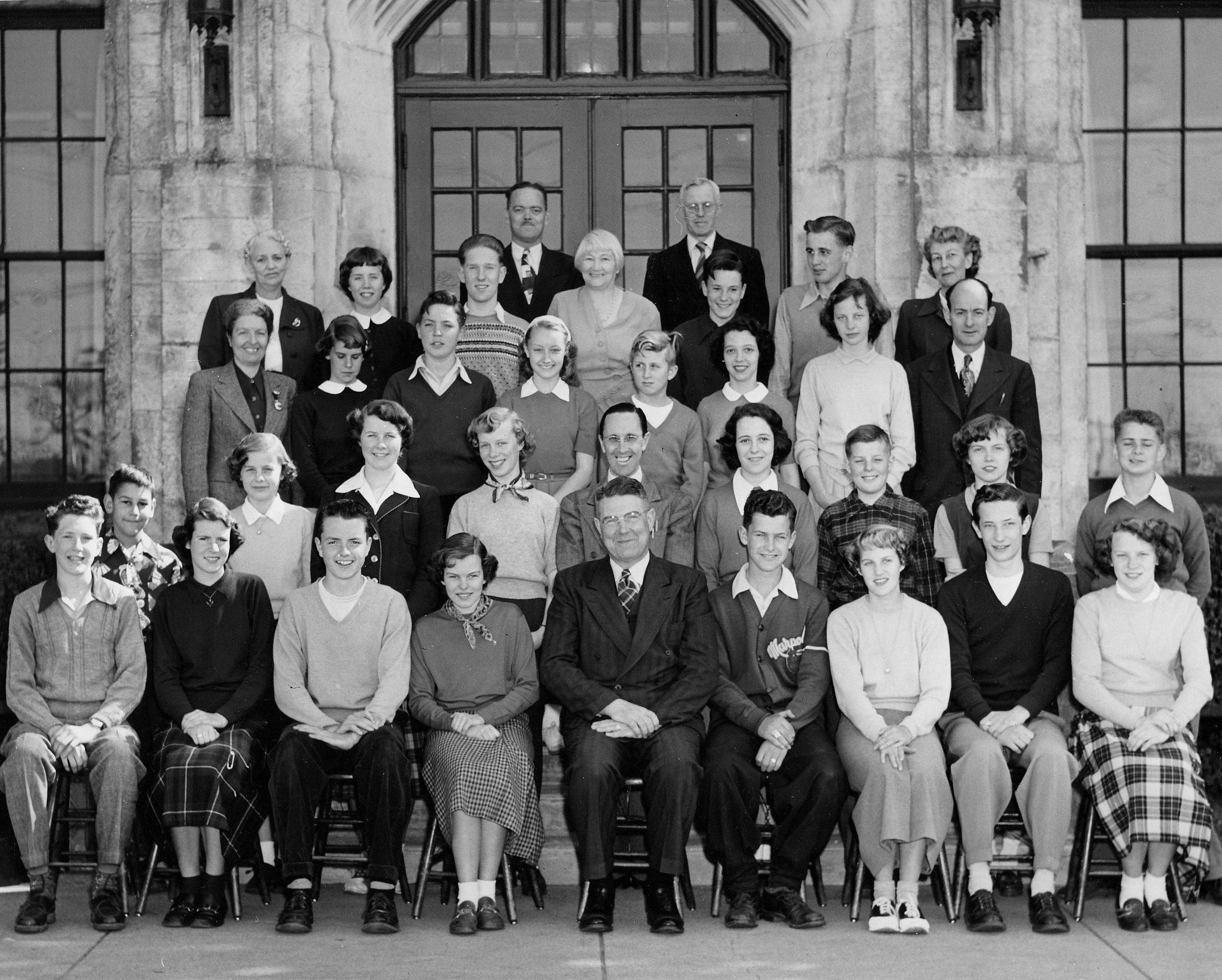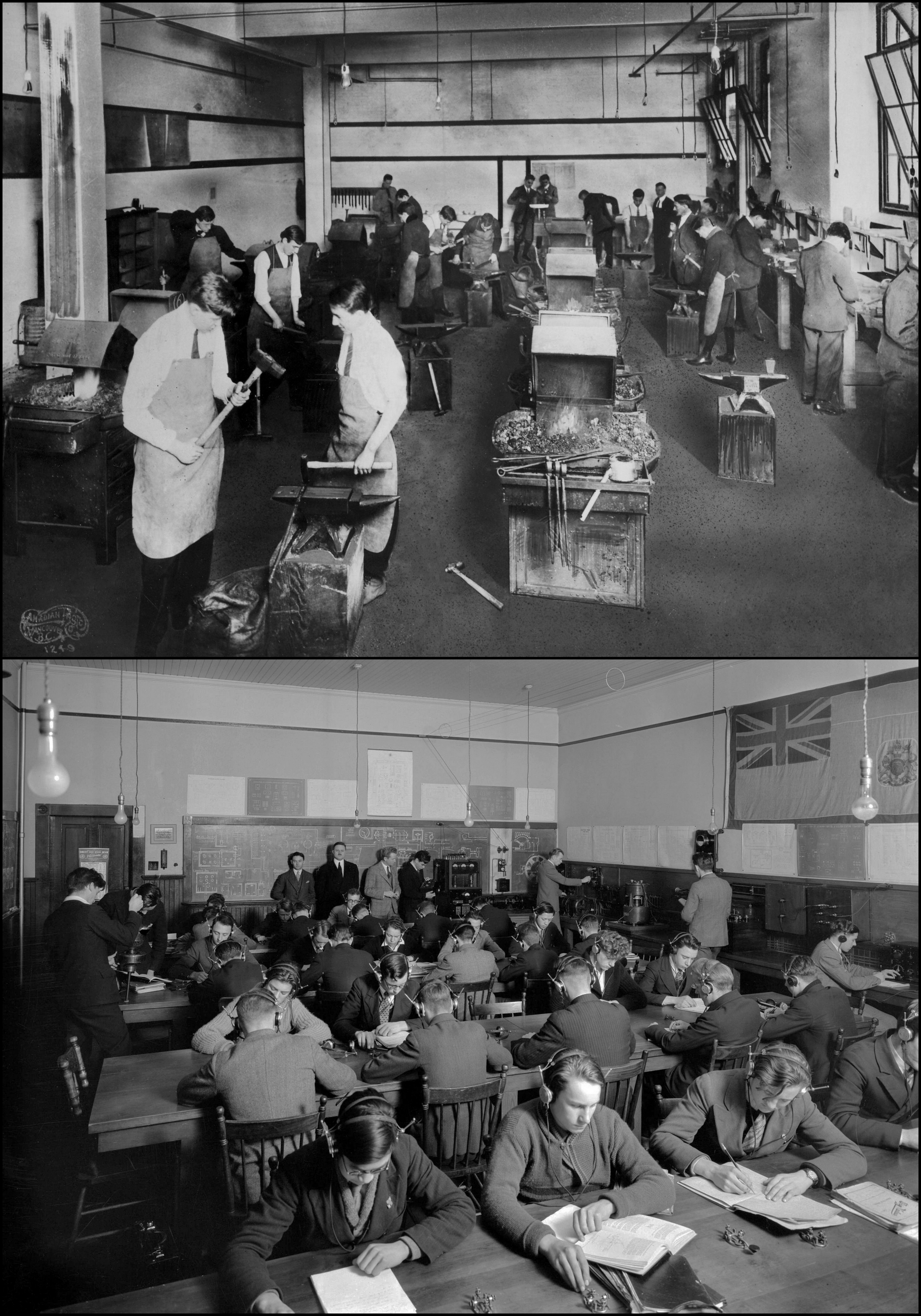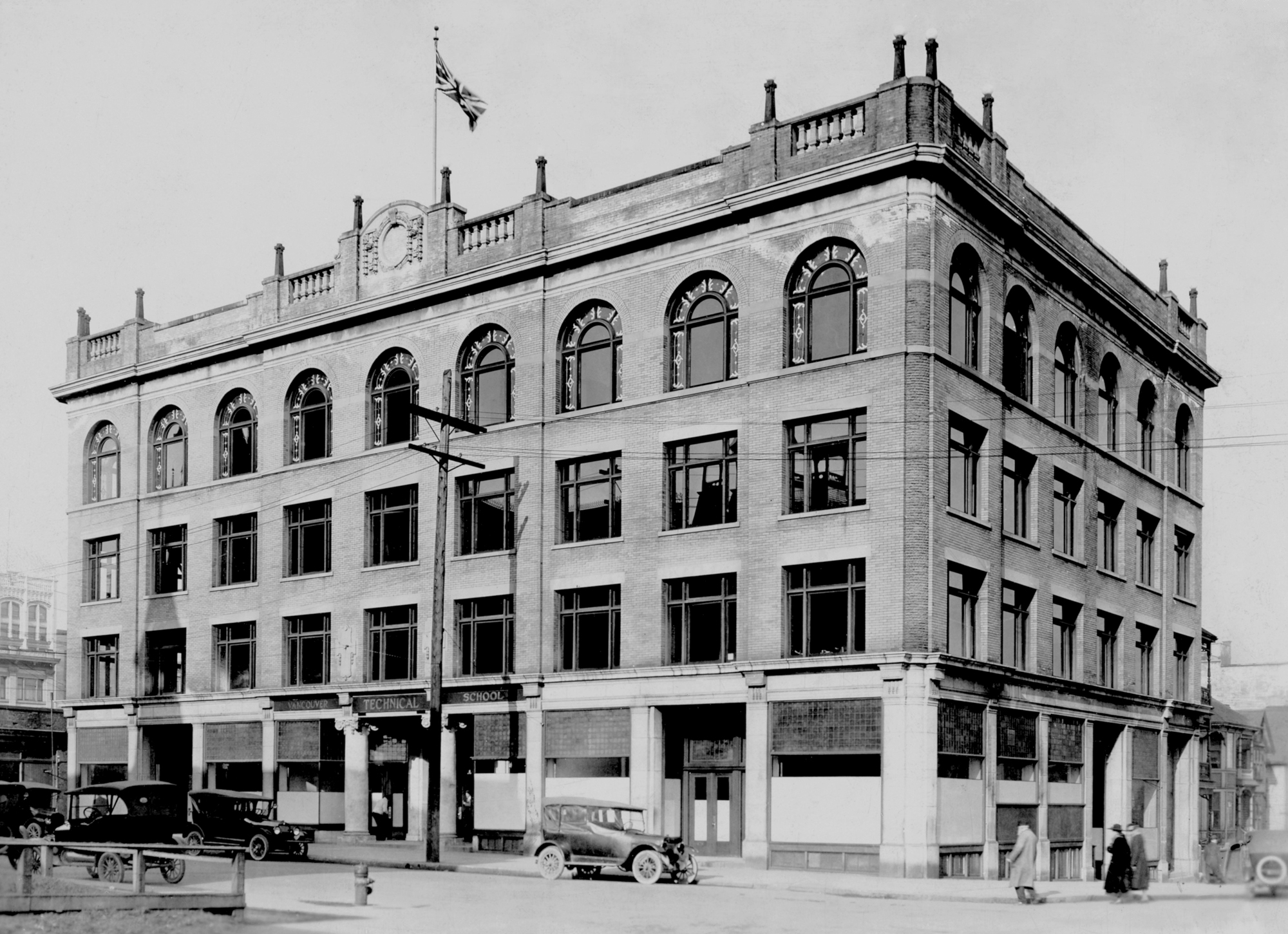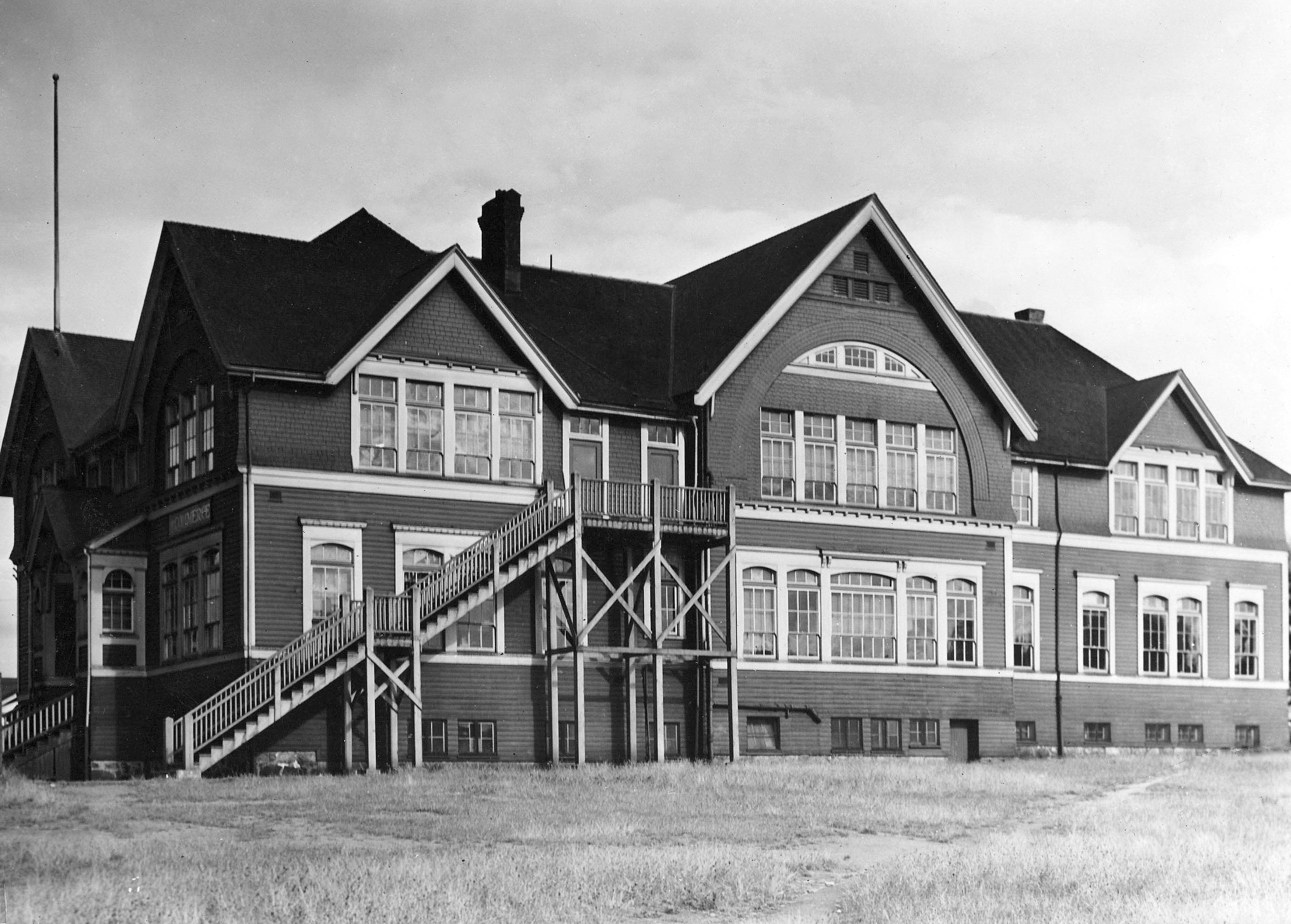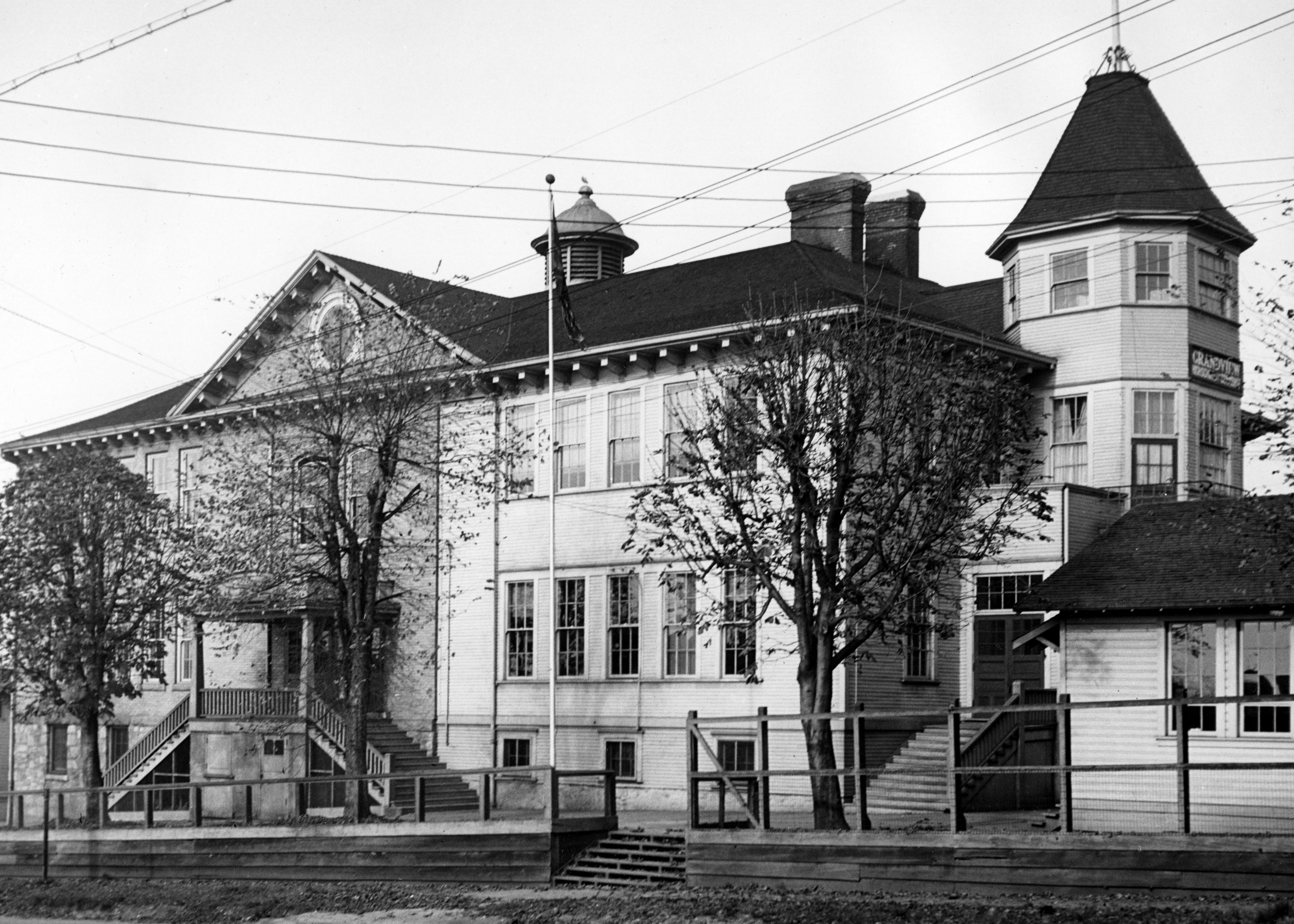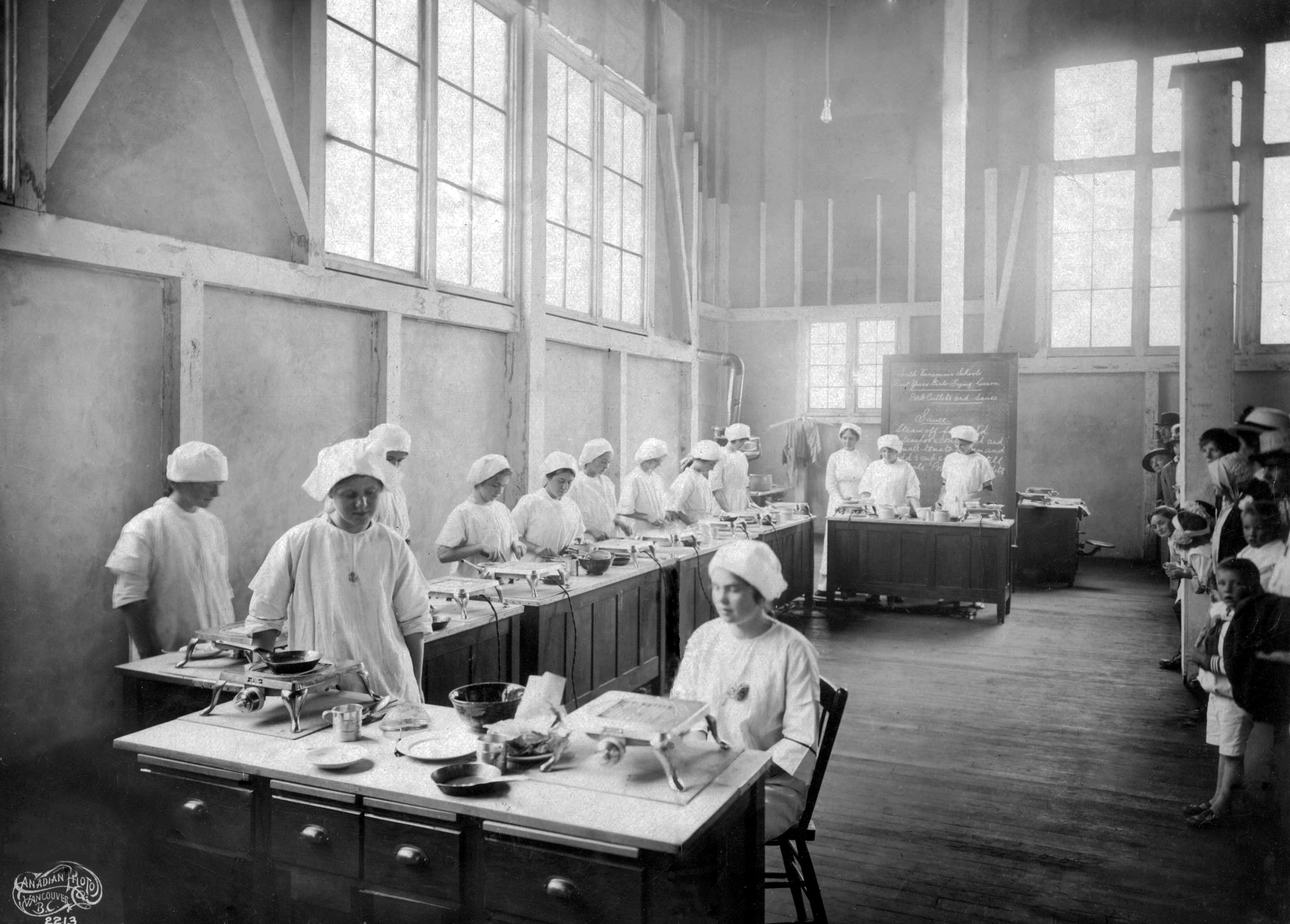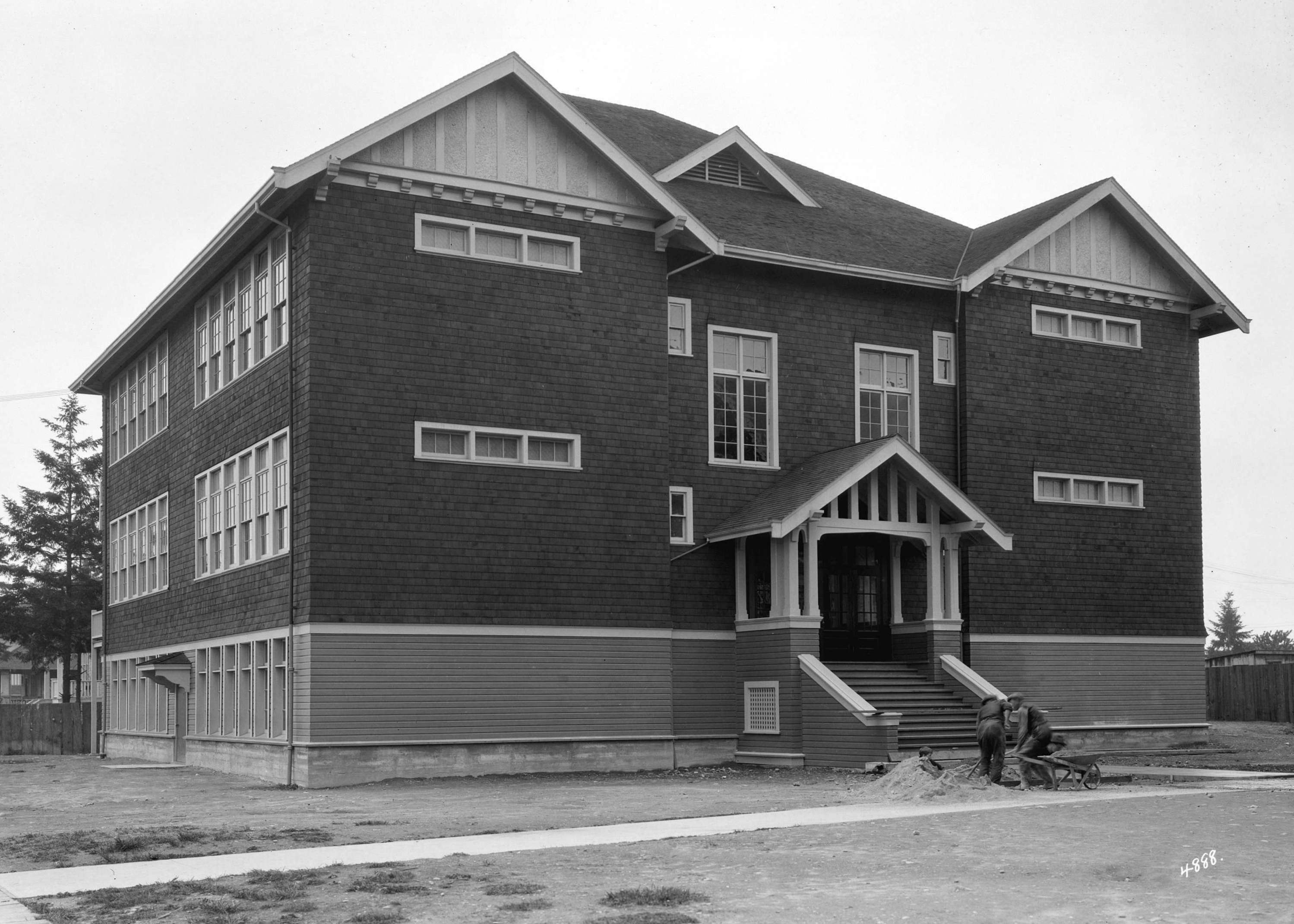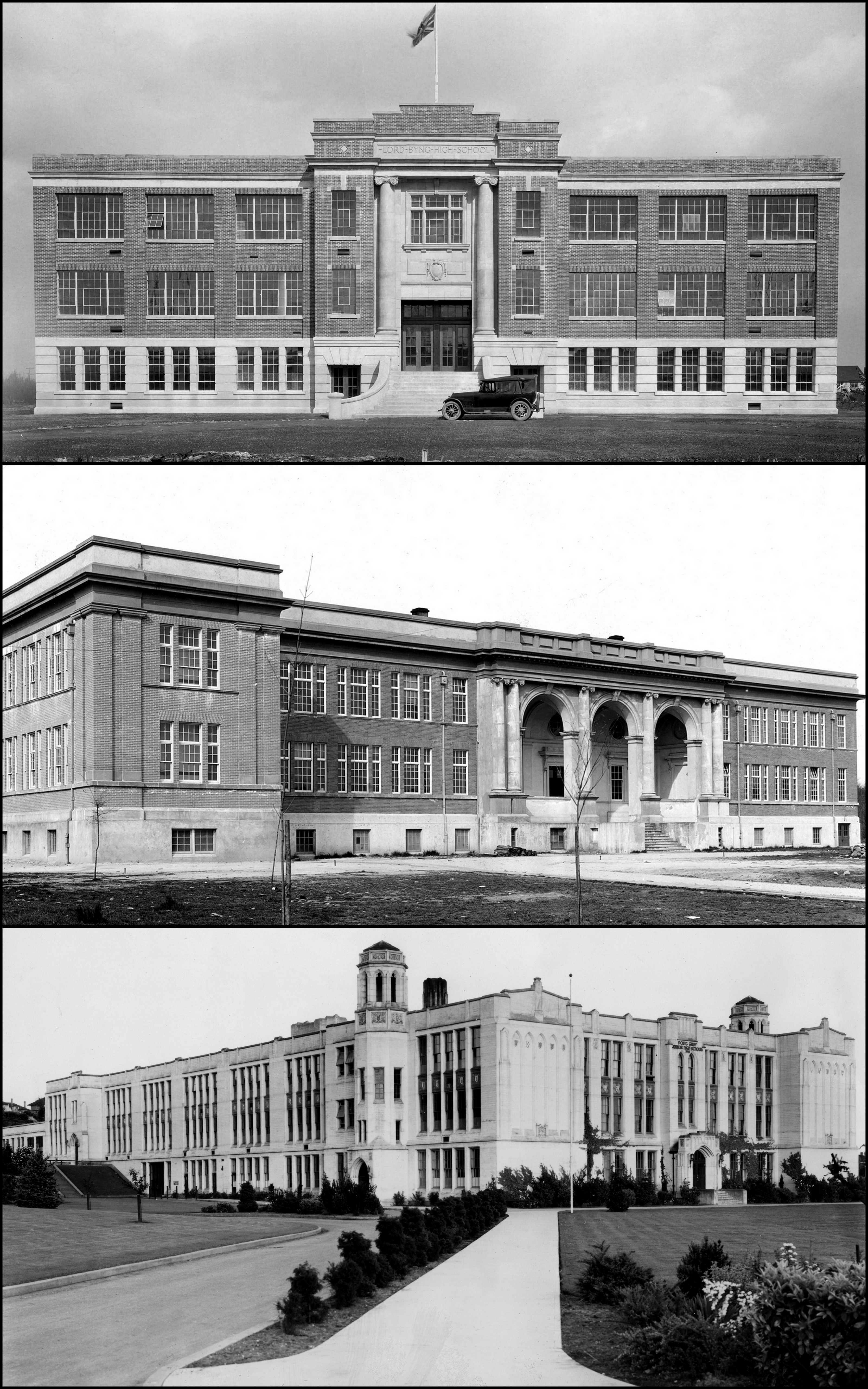Chapter Three: 1911 – 1930
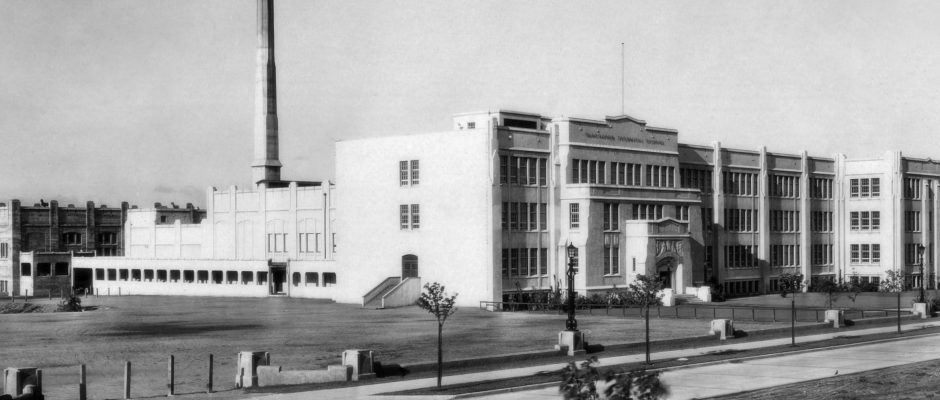
Vancouver Technical High School as it looked shortly after it opened in 1928. For many years, it was the largest technical school in Western Canada. Only boys attended the school until 1940, when it became co-educational.
Introduction
This period was marked by ‘boom and bust’ cycles in the global economy, a brutal world war, and a killer international influenza epidemic, each of which had a major impact on Vancouver and its emergent public school system.
Veterans of World War One: VSB School Board employees gather in front of the VSB School Board Offices (1932)
Decade: 1911 – 1920
Timeline:
1910 Faced with a rapidly growing student population, the Vancouver School Board hired the architect, Norman A. Leach to design and supervise the construction of several new schools, and increase the size of a number of existing schools.
Leach’s major contribution was the development of a standard plan often described as a ‘barbell’ plan, having a central lateral spine, with the entrance in the centre of one long side, and a wing at either end, projecting both towards the front and back. .. The spine usually contained classrooms and the school office, accessed by a corridor and a central hall at the entrance, and each wing would have a further eight classrooms.
Florence Nightingale Elementary School (built in 1912)
Spaces inside the school were carefully segregated on the basis of gender and status. Thus, schools had separate entrances for adults and children. Staff lunchrooms were mixed, but separate retiring rooms were provided for male and female staff… Both indoor and outdoor space was gendered – girls and boys generally played in separate spaces inside and out.
Excerpt from Vancouver Schools: Establishing their Heritage Value
1911 Dr. W.D. Brybone-Jack, Chairman of the Vancouver School Board, sets out a bold vision for Vancouver’s public schools.
In 1911, ‘In a cosmopolitan city like Vancouver, our educational system should be able to reach out and benefit all classes and all ages, it should endeavor to raise the standard of our citizens morally, socially, and financially from the youngest to the oldest.
Excerpt from Vancouver Schools: Establishing their Heritage Value
1912 The real estate boom that had begun in Vancouver in 1904, ended abruptly. Property values plunged by more than half. A year later, a global depression occurred, severely affecting international trade. For Vancouver, a port city, this was a major setback, but it did not undo the remarkable transformation the City had gone through since the turn of the century.
Although various examples of continuity and stability can be uncovered, the dominant motif in Vancouver’s development from the turn of the century to World War I was one of growth and change. The quadrupling of population, the massive influx of migrants from the British Isles with their distinctive styles and beliefs , the disappearance of the intimate small town quality and the development of a more impersonal city with an increased national and international orientation, the construction of an elaborate street railway system and the subsequent expansion of the physical city from about two square miles to some thirty square miles, the establishment of well-defined commercial, industrial, and residential districts with distinctive shadings in price and prestige, the construction of miles of streets and sidewalks, and thousands of homes, offices, stores, and business blocks all combined to make this one of the most significant periods in Vancouver’s history. Indeed the basic character and appearance achieved by 1914 would still be clearly recognizable not only in 1924, but in 1934, as well in 1944. Not until the 1950’s and 1960’s would Vancouver again experience a transformation of comparable magnitude.
Excerpt from A Critical Growth Cycle for Vancouver, 1900-1914, Norbert MacDonald
***
One of the most remarkable stories from this time involves 67 members of the Vancouver High School Cadets Corp. On July 10, 1912, they, along with a small contingent of senior officers, embarked on the R.M.S. Zealandia on a five-month tour of Australia and New Zealand. The following passages document their experiences:
At every port of call some new experience awaited. The modern educational maxims, “learn by doing” and “learn by seeing”, were given full scope. Trade winds, westerly winds, tropical fruits and vegetation, native peoples, flying fishes, whales, ships at sea, doldrums, storms, marine sunsets, the Southern Cross, and many lasting experiences filled the mental notebooks of the cadets. Their coming symbolized the unity of thought, constancy of purpose, and loyalty to the same Motherland, which characterizes citizens of the Empire in all parts of the world.
July 1912: Members of the Vancouver High School Cadets Corp march down Georgia Street in parade formation prior to their departure for Australia and New Zealand. Photo credit: Vancouver City Archives.
It was ordained that many Canadians on that tour met Australians again on the battle-fields of Flanders in the Great War, and, with their blood attested the love of those things for which the Empire stands.
Excerpts from First Fifty Years 1890 – 1940 Vancouver High Schools
(Note: records show that all the junior officers and most of the cadets went on to serve in World War One, and that five of the junior officers and at least 6 of the cadets were killed in action.)
The origin of the Vancouver Cadet Corps is rooted in the creation of the Strathcona Trust in 1909-1910. This Trust was established by Lord Strathcona, Canada’s High Commissioner to Great Britain. Lord Strathcona was motivated by the Syllabus of Physical Training recently adopted by elementary schools in Great Britain.
According to the terms of the trust, the fund was to be used not only to promote physical training but also to encourage the formation of military cadet corps within the public schools. Thirty-five per cent of Strathcona Trust funding was supposed to be allocated to cadet training, fifteen percent to rifle shooting, and fifty per cent to physical education.
British Columbia accepted the terms of the Strathcona Trust in 1910. Two years later, in 1912, physical education became a compulsory subject in the public schools British Columbia.
In City and Municipal school districts, callisthenics and other drills were conducted by non-commissioned officers on load from the Militia Department. The military also loaned instructors to the Normal Schools where teachers were taught physical training according to methods laid out in the Strathcona Trust’s Syllabus of Physical Exercise for Schools.
Excerpts from The Strathcona Trust and Physical Training in B.C. Public Schools
1914 The Komagata Maru ‘Incident’
Canadian immigration officials prepare to board the Komagata Maru (May 1914). Photo credit: Vancouver City Archives.
The Komagata Maru was a ship chartered by a Sikh business man named Gurdit Singh Sirhali to bring 376 passengers, all British subjects, and mostly Sikh men from the Punjab region of India, to British Columbia, where they hoped to find work in saw mills or on construction projects. They had been drawn by stories they’d heard from earlier Indian migrants who, in 1908, had been brought to B.C. as labourers. These men earned wages much higher than those paid in India, and they encouraged acquaintances back home to join them in B.C.
However, their presence provoked a backlash in the white population, particularly among labourers who saw the men as a threat to their livelihood, but also among those who held racist views towards Asian peoples in general. In response, the Canadian government brought in a regulation that stated that immigrants must:
“…come from the country of their birth, or citizenship, by a continuous journey and on through tickets purchased before leaving the country of their birth or citizenship. “
The huge distance between India and B.C. made continuous voyages impossible, so this regulation effectively barred immigration from India. Gurdit Singh Sirhali was not deterred. He thought that the regulation could be challenged successfully in a Canadian court, and if that failed, angry protests by Sikh troops in India against such a ruling would persuade the Canadian government to drop the regulation. If that had happened, the door would have been opened to increased immigration from India to Vancouver (and elsewhere in Canada), and that would have increased the ethnic diversity of Vancouver’s student population.
In the end, Gurdit Singh Sirhali’s hopes were dashed. Upon arriving at Vancouver, the Komagata Maru was barred from docking. After two months at anchor off the CPR Pier A, only twenty ‘returning’ passengers had been granted admission to Canada. On July 23, a Canadian warship, the HMCS Rainbow escorted the Komagata Maru out of Vancouver’s harbour. When the ship reached India, clashes broke out between British authorities and many of the passengers. Nineteen were killed. Others were arrested and imprisoned.
1914 – 1918 World War One
The outbreak of war in Europe in August 1914 began as a contest between two alliances: Britain, France, and Russia on one side, and Germany, Austria Hungary, and the Ottoman Empire on the other. Great Britain’s declaration of war on August 04 made Canada automatically at war because it was part of the British Empire.
In Vancouver, hundreds of young men caught up in the patriotic furor sweeping the city, gathered at recruitment offices. Very soon, they were on trains headed east to the Valcartier Training Camp near Quebec City. At the end of February 1915, many were in action, experiencing the brutal reality of trench warfare first hand.
A train of new recruits departs Vancouver’s Canadian Pacific Railway Station (1914). Photo credit: Vancouver City Archives.
During the war, cadet corps were formed in many of Vancouver’s schools. This program continued to operate until 1933.
Pictured: Cadet corps from several Vancouver elementary schools and high schools.
In Vancouver, wartime enlistments led to a slump in population growth that lasted into the early 1920s. More than 1400 city residents were killed in action. Graduates of King Edward High School made a huge contribution to the war effort, and paid a heavy price. Records show that 750 grads served in the war and that 101 of these made the ‘ultimate sacrifice.
Many more who returned from the war bore debilitating scars – both physical and psychological – that marked them and their families for the remainder of their lives.
***
During the First World War, construction of new schools came to a complete stop. This pause lasted until 1919, a year after the war ended.
1911-1914 1915-1919
City of Vancouver
- Elementary schools and annexes 14 Nil
- High Schools Nil 1
Municipality of South Vancouver
- Elementary schools and annexes 15 Nil
- High Schools 1 Nil
Municipality of Point Grey
- Elementary schools and annexes 2 Nil
- High Schools Nil Nil
1918-19 The Great Flu Epidemic
The First World War, which ended in an Armistice on November 11, 1918, was the most deadly conflict in history to that date. An estimated 17 million people died (11 million military and 7 million civilian), and 20 million people were wounded.
However, the global flu epidemic which broke out in October 1917 killed even more people in a shorter time. In six months, 20-40 million people died, most deaths coming in October and November 1918. The highest death rate occurred among young adult in their 20s and 30s, with the major peaks coming in waves, in October and November 1918, and January 1919. The British Columbia Board of Health estimated that about one-third of the population came down with the illness.
Among eighteen of the largest cities in North America, Vancouver suffered the third highest death rate at 23.3 deaths per 1000 of population. (In comparison, Toronto had a death rate of 14.3; Seattle’s death rate was 11.1.) The total number of deaths in Vancouver was 795.
This must have been a terrifying time. Doctors and other medical personnel worked themselves to exhaustion as they struggled to find effective strategies to combat the illness. Initially, Dr. Frederick T. Underhill, Vancouver’s Medical Health Officer, was opposed to ordering a ‘town closure’, which would have seen the banning of public gatherings and the closure of schools and other public facilities such as churches and recreational centres.
Underhill was particularly opposed to the closing of schools:
“He believed it would be positively harmful to the health of children, who, with schools closed, would be removed from the close surveillance of teachers and school medical staff on guard for influenza symptoms, and would instead be free to roam the streets, exposing themselves to various sources of infection and neglecting early signs of the disease.”
Excerpt from Epidemic and Public Health: Influenza in Vancouver, 1918-1919 by Margaret W. Andrews
In the end, officials of the Vancouver School Board ordered a temporary closure of schools on October 18, 1918, citing the fact that this seemed to be what the public desired. (By this time, the absentee rate in Vancouver’s schools had risen to more than 10 percent.)The city Health Committee moved swiftly to convert King Edward High School into a temporary hospital capable of handling up to 1000 cases. Strathcona Public School was also converted to a hospital for the local Japanese community. These schools soon reopened. They were not used as temporary hospitals during subsequent surges of the epidemic.
King Edward Matriculating Class: 1919. During the height of the global flu epidemic, their high school was shut down for a short time to serve as a hospital for flu victims.
Decade: 1921 – 1930
During this period, the population of Vancouver increased substantially. In 1921, the population of the City of Vancouver was 117,000. By 1931, it had grown to 246,000. One reason for this dramatic increase was that in 1929, the Municipalities of South Vancouver and Point Grey had amalgamated with the City of Vancouver. Construction of new schools also resumed, but at a relatively slow pace. Crowding became an issue in several schools.
Student population grew rapidly, particularly the high school population. In 1891, there were just 31 students housed in a temporary 2-room wooden building. By 1923, this number had grown to 2280 students attending several different high schools.
Vancouver’s economy boomed. The opening of the Panama Canal in 1914 opened up markets for B.C.’s forest products in Europe and along the eastern seaboard of the United States. Also, the B.C. government was successful in lobbying for lower freight rates through the Canadian Rockies. This promoted rapid growth in the export of prairie wheat through the Port of Vancouver. In less than 10 years, the number of grain elevators situated on Vancouver’s waterfront grew from one to six.
The growing use of electrical power and the mass production of automobiles increased demand for B.C. metals and minerals such as lead and zinc. Large quantities of lead and zinc concentrates were shipped through the Port of Vancouver.
Automobile ownership in Canada increased rapidly. By 1929, the number of automobile owners had passed one million. In Vancouver the popularity of automobiles led to a decline in the profitability of street railways.
New technologies transformed people’s lives. The invention of radio and motion picture gave rise to mass media that increased American influence on Canadian culture and identity. By 1926, six radio stations were operating in Vancouver. Movie theatres such as the Capital, Columbia, Lyric, Orpheum, Princess, Rex, Stanley, and the Strand, drew crowds to Downtown Vancouver during the 1920s.
Granville Street as it was in the 1920s. Note the street cars and automobiles. The Capital movie theatre is on the right. Photo Credit: Vancouver City Archives.
On January 01, 1929, the City of Vancouver and the municipalities of Point Grey and South Vancouver amalgamated. The combined population of 240,000 made Vancouver the 3rd largest city in Canada. The population of the three school districts (22,000, 6400, and 8900) added up to more than 37000 students, making the Vancouver School District one of the largest school districts in Canada.
- Design and Construction of New Schools and School Grounds
Many schools show an inexcusable waste of public money in their construction. Domes, turrets, cupolas, cut-stone trimmings, ornate cornices, mouldings, and beamed ceilings, unnecessary outside entrances, are features that have cost the ratepayers an enormous sum and contribute nothing to the efficiency of the school system.
Excerpt from the Putnam-Weir Report of 1925
The end of the First World War did resolve Vancouver’s woes. Unlike Point Grey and even South Vancouver, Vancouver was unable to convince ratepayers to endorse expenditures on school construction… All told, by 1924, Vancouver had 167 temporary classrooms.
After 10 years of minimum funding, Vancouver succeeded in convincing ratepayers to pass school-building bylaws from 1924 to 1928. These bylaws funded the completion of a number of the schools built during the 1910-14 era.
Cheaper building methods were adopted across the system, with stucco finishes evident at Kitsilano, Templeton, and most other schools of the period. Exterior ornamentation was more restrained, although not entirely eschewed.
Where the Board did not compromise was on the question of fireproof construction (e.g., concrete rather than ‘millwork’ construction.
With its shops, auditorium, gymnasium, domestic science, and commercial rooms, Templeton clearly reflected the expanded curriculum of the time as well as the increased emphasis on vocational training.
Three factors drove the development of school grounds. There was the issue of aesthetics: citizens complained about muddy, unfinished grounds. Pragmatic concerns also came into play. Trustees fretted about school grounds that were quite literally washed away in heavy rainfall… Another factor was related to the educational reform movement, which combined with urban reformists to urge the development of physical education and supervised playgrounds in schools and park.
Excerpts from Vancouver Schools: Establishing their Heritage Value
New Schools: City of Vancouver, Municipality of Point Grey, Municipality of South Vancouver (1920 – 1929)
Elementary Annex K – 12 Jr. High School High School
9 7 2 3 6
- Educational Program
a) A Common Educational Experience
Neil Sutherland, in his work on education in Vancouver in the inter-war period, concludes that parents across the City agreed in general about what form schooling should take. He found that while childhood experiences differed quite considerable from neighbourhood to neighbourhood outside of school, in school their experiences were remarkably similar. This meant that all children were exposed to a uniform curriculum that shored up ‘Anglo’ values. From this Sutherland concludes that ‘Vancouver schools sorted children within schools rather than between schools.
Excerpt from Vancouver Schools: Establishing Their Heritage Value
b) Proposed Reforms
J.H. Putnam, Senior Inspector of Schools, Ottawa, and G.M. Weir, Professor of Education at UBC and later Minister of Education conducted a systematic survey of the British Columbia school system in 1925. They found that most classrooms remained quite formal – lessons were teacher-led and subjects were differentiated rather than integrated….The emphasis was on learning from books through drill. Copy-work, often from the board, was an important part of the instructional routine, and so blackboard space was carefully managed and maximized.
Classroom at Shaughnessy School, 1920
Recommendations made by Putnam and Weir:
- Standardization and broadening of the curriculum, including more practical subjects and physical education
- Standardizing the time allotted to subjects
- Introduction of ‘junior high school’ and the shifting to a program of six years at elementary schools, three years at junior high school, and three at high school, with the high school program divided into academic, commercial, general, and normal school preparation, elimination of high school entrance examinations
- Higher standards for admission to teachers’ training
- More use of the project method of instruction
Excerpts from Vancouver Schools: Establishing Their Heritage Value
During the next two decades, school authorities acted on several of these recommendations, particularly those calling for changes in how schools and instructional programs were organised.
- School Organisation
a) PLATOON SYSTEM
In a development of the classroom system, several Vancouver schools adopted the platoon system. Promoted by efficiency experts, platoons were intended to maximize efficient use of the school plant. This system of organisation was introduced at Lord Tennyson School in 1924-25, and was introduced to progressively more schools through to the 1940s. Drawing on the industrial model, systems of electrical bells manufactured by IBM, still in evidence in many Vancouver schools, were used to signal the time and rotations precisely.
Excerpt: from Vancouver Schools: Establishing their Heritage Value
b) INDIVIDUAL TIMETABLES FOR STUDENTS; PROMOTION BY SUBJECT
The intention of these innovations was to give high school students the opportunity to choose course of studies that reflected their interests and abilities, thereby increasing their chances of completing their high school program.
c) GRADE RANGE
Up until the 1920’s, the standard grade ranges for Vancouver’s schools were as follows:
- Elementary: eight grades defined by age
- High School: four grades defined by subject level
Beginning in 1920, alternative grade-range models were in use in a number of schools:
K – 12 schools
Prince of Wales (Municipality of Point Grey) 1920 – 1960
University Hill (University Endowment Lands) 1927 – 1954
Junior High Schools
Junior High Schools were seen as a way of easing the transition of students between elementary school and high school. This model soon lost favour. By 1965, the two former junior high schools in Vancouver were operating as high schools with full Grade 8 – 12 programs.
Templeton 1927- 1965
Point Grey 1929 – 1965
Group photo: school principal, staff members and students (1951)
- Broadening of the High School Curriculum
Perhaps the biggest change in Vancouver’s educational system in the interwar period was the continuing broadening of the secondary school curriculum… high school options were diversified, with vocational alternatives and with the continued development of specialized high schools.
While these courses broadened access, they were established within an environment that stressed the use of scientific tools, such as intelligence testing, to stream students into the vocational stream that best reflected their abilities. While this was seen as the most efficient use of educational resources at the time, the streaming system tended to perpetuate and reproduce social inequalities based on class and race.
Excerpts from Vancouver Schools: Establishing their Heritage Value
a) TECHNICAL EUCATION
During the period 1916 – 1930, technical education in the Vancouver School District was carried out, in turn, in three school buildings.
King Edward High School (1916 – 1921)
At the high school level, Vancouver introduced a work-preparation program (pro-vocational) in 1916 and technical courses in 1919, both at King Edward High School. The purpose of these courses varied from providing specific skills training and to preparation for work through general exposure to the routines of work. The difficulty of the courses also varied, from preparation for university engineering programs, to trades focused programs to remedial work.
Excerpt from Vancouver Schools: Establishing their Heritage Value
Top: Students in metalwork shop (1916) Bottom: telegraphy class (1930).
At present there is at the King Edward High School a course of technical study designed with the view to fitting students who are going to take up technical work in after life, to equip themselves more efficiently for such work that is general in high schools.
The syllabus comprises a course in English, Latin, Mathematics, including its higher branches, business forms and usages, drawing, shop work, which includes woodwork, metal work, and work shop drawing, mechanics and physics.
Excerpts from an article that appeared in the Daily Province in 1916.
Labor Temple (1921 – 1928)
Once inside their own school the boys developed a very remarkable school spirit, and this was evinced by their general attitude around town. There was no playground, except the alleyway and the business section of the city, but the police visited the school only twice; once because a bold boy cycled on the sidewalk, and a second time when a window was broken by a football. Twice the boys hired special B.C. E. R. street cars to convey their teams and themselves to the combat fields of sport and glorious was their enthusiasm.
The Labor Temple was not ideal for a school, but some of the best years in the school’s history were spent there. The boys still had the pioneer spirit, had a splendid attitude toward study, and were healthy young beings, enjoying life to the full, and yet with a canny eye to the future.
Excerpts from THE FIRST FIFTY YEARS Vancouver High Schools 1890 -1940
Vancouver Technical High School (1928 – present)
In the commodious new building, the largest technical institution in Western Canada, enrollment in the period 1928-1940 nearly trebled. Numerical growth made possible the introduction of many more optional courses including instruction in automotive engineering, in mining and lumbering, in steam and diesel engineering, and in cooking. The editor of the 1938 school annual, in commenting on the passing of the by-law making provision for the construction of a wing to house girls’ technical classes, viewed the venture as “the greatest change in 18 years”. In facetious vein, the editor further remarked: “One hesitates between congratulating this year’s graduates upon what they have escaped and commiserating with them on what they have missed.
Excerpt from THE FIRST FIFTY YEARS Vancouver High Schools 1890 -1940
Vancouver Technical School: A ‘Boys Only’ school until 1940.
b) SCHOOLS OF COMMERCE
Fairview High School of Commerce (1918 – 1963)
The Fairview High School of Commerce had its beginnings in the King Edward High School during the early years of the century, but did not come into existence as a separate institution until September 1918.
In September 1918, the commercial classes were removed from the King Edward High School and were given accommodation in the Cecil Rhodes Elementary school building.
In September, 1921, the school was moved from the Cecil Rhodes building and again given rooms in the King Edward building. Here it remained until June, 1935, when, with the exception of the class in Wireless Telegraphy, all classes were moved to the Fairview and Seaview buildings.
In September, 1921, the name of the school was changed from the Cecil Rhodes School of Commerce to the High School of Commerce, and to this name was later prefixed “Fairview
Excerpts from THE FIRST FIFTY YEARS Vancouver High Schools 1890 -1940
Follow this link to see more photos of the Fairview High School of Commerce: Fairview High School of Commerce
Granville High School of Commerce (1913 – 1950)
Granville High School of Commerce had its beginnings as a Commercial Department of Britannia High School under the principalship of Mr. T.A. Brough, in the school year of 1913-1914… The commercial subjects, consisting of Shorthand, Typewriting, Bookkeeping, Commercial Law, and Commercial Arithmetic were taught by Mr. Taylor; Miss Davis gave instruction in the academic subjects
By 1926-27 the department had increased to nine classes. It was impossible to find sufficient accommodation for all these students at Britannia High School, and five senior classes were housed at Charles Dickens Elementary School.
In the spring of 1927 the five classes housed at Charles Dickens elementary school were moved to quarters in the old Grandview School building at the corner of First Avenue and Commercial Drive. In September, the organization of Templeton Junior High School took away two grade nine classes. This made possible the accommodating of all the classes of the Commercial Department in the Grandview building.
By 1932-33, the school had increased to nine classes and, although its organization was entirely separate, it was still considered as part of Britannia High School. Th School Board now deemed it advisable to establish the school as a separate unit.
Excerpts from THE FIRST FIFTY YEARS Vancouver High Schools 1890 -194
Follow this link to see more photos of the Grandview School of Commerce: Grandview High School of Commerce
5. Elementary and Secondary Schools
CITY OF VANCOUVER
Elementary Schools
1911 Henry Hudson, Lord Nelson, Lord Tennyson, Shaughnessy
1912 Charles Dickens, Florence Nightingale, General Gordon, Sir John Franklin
1913 Laura Secord (#2)
1914 Bayview, Lord Kitchener, Sir William Dawson (#2)
1921 Langara (also known as Dunbar Heights and Kitchener Annex A), Sir Wilfred Grenfell
1926 Grandview
1928 Renfrew
1930 Sir Matthew Begbie
Annexes
1911 Charles Dickens Annex A
1923 Prince of Wales Annex, Sir John Franklin Annex
1929 Simon Fraser Annex
1923 Kitsilano
1927 Templeton
1928 Vancouver Technical
DISTRICT OF SOUTH VANCOUVER
Elementary Schools
1911 Block 44 School, General Wolfe, Lord Selkirk, Sir Guy Carleton
1912 Eburne Superior School (see: Eburne Public School), J.W. Sexsmith, Laura Secord (1), Sir Richard McBride, Sir William Van Horne
1912 Champlain (1), Sir Sanford Fleming
1913 Connaught, David Livingstone, John Norquay
1921 General Gordon (1), later called Sir Sanford Fleming
1928 Capt. James Cook (1)
1929 Sir James Douglas (1)
Annexes
1926 Lord Beaconsfield Annex (A)
High Schools
1912
1920 John Oliver
DISTRICT OF POINT GREY
Elementary Schools
1914 Maple Grove, Magee Public
1915 Queen Mary
1920 Edith Cavell, Strathcona Heights
1921 David Lloyd George
1924 Quilchena
1926 Queen Elizabeth, Queen Elizabeth Annex
High Schools
1924 Lord Byng
1926 Magee
1928 Point Grey
7. MILESTONES IN PUBLIC EDUCATION (excerpts from A Short History of BC Education, University of Victoria)
- 1915 The first Parent-Teacher Association is launched at Craigflower School near Victoria on 8 September 1915. In November, PTAs are formed at Bayview Elementary School and at King Edward High School in Vancouver.
- 1919 The British Columbia Teachers’ Federation is incorporated under the Benevolent Societies Act.
- 1922 Local PTAs form a provincial association known as the British Columbia Parent-Teacher Federation [BCPTF].

